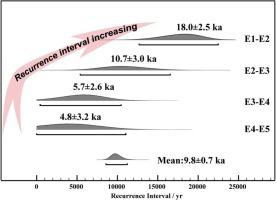Paleoearthquake sequence in the eastern segment of the Serteng Shan frontal fault (Hetao graben, North China) during the last 50 ka
IF 2.6
3区 地球科学
Q2 GEOCHEMISTRY & GEOPHYSICS
引用次数: 0
Abstract
To better constrain the paleoseismicity and assess the seismic hazard, we investigated the eastern segment of the Serteng Shan frontal fault along the northern margin of the Ordos Block. The Ordos Block in northern China has a stable interior but is surrounded by seismically active faults. Several historical earthquakes with magnitude ≥M7 have ruptured along the northern boundary of the Ordos Block. Using excavated trenches, the eastern segment of the Serteng Shan frontal fault along the northern margin of the Ordos Block was investigated. Seven events were identified based on distinct geological markers, such as colluvial wedges. To constrain the timing of these events, 28 samples were collected and dated using the optically stimulated luminescence (OSL) method. The dating indicates show that all seven events occurred after ∼90 ka, with the five most recent events occurring after 50 ka. Based on OxCal modeling results, the most recent event is inferred to have occurred at 7.0 ± 1.1 ka. The penultimate and preceding events occurred at approximately 25.0 ± 2.2 ka, 35.6 ± 1.5 ka, 41.3 ± 1.9 ka, and 46.2 ± 2.4 ka, respectively. The minimum recurrence intervals are approximately 5 ka, or multiples thereof, resulting in longer intervals of up to ∼20 ka. Combining the displacement of the T6 terrace and their corresponding ages, a uniform vertical slip rate of 0.15 ± 0.02 mm/yr over the last 90 ka is estimated. The slip rates and recurrence intervals indicate that the eastern segment of the Serteng Shan fault experiences a low rate of surface-rupturing earthquakes. This behavior could be explained by the effect of unloading of a mega-paleolake in the Hetao Basin at ∼50 ka. These results provide new constraints on long-term slip behavior and inform seismic hazard assessment.

近50 ka来色腾山前缘断裂东段(华北河套地堑)古地震序列
为了更好地约束古地震活动性和评价地震危险性,我们对鄂尔多斯地块北缘的蛇腾山前缘断裂东段进行了研究。中国北部的鄂尔多斯地块内部稳定,但被地震活跃的断层所包围。历史上几次震级≥7级的地震沿鄂尔多斯地块北部边界破裂。利用开挖沟对鄂尔多斯地块北缘蛇腾山前缘断裂东段进行了研究。根据不同的地质标志,如崩积楔,确定了七个事件。为了限制这些事件发生的时间,我们收集了28个样品,并使用光激发发光(OSL)方法测定了它们的年代。测年结果表明,这7个事件都发生在~ 90ka之后,最近的5个事件发生在50ka之后。根据OxCal模拟结果,推断最近的事件发生在7.0±1.1 ka。倒数第二和前两个事件分别发生在25.0±2.2 ka, 35.6±1.5 ka, 41.3±1.9 ka和46.2±2.4 ka。最小的重现间隔约为5 ka,或其倍数,从而产生更长的间隔,可达~ 20 ka。结合T6阶地的位移及其相应的年龄,估计了近90 ka的均匀垂直滑移速率为0.15±0.02 mm/yr。滑移率和复发间隔表明,瑟腾山断层东段地表破裂地震发生率较低。这种现象可以用河套盆地大型古湖泊在~ 50 ka卸荷的影响来解释。这些结果为长期滑移行为提供了新的约束条件,并为地震危险性评估提供了信息。
本文章由计算机程序翻译,如有差异,请以英文原文为准。
求助全文
约1分钟内获得全文
求助全文
来源期刊

Tectonophysics
地学-地球化学与地球物理
CiteScore
4.90
自引率
6.90%
发文量
300
审稿时长
6 months
期刊介绍:
The prime focus of Tectonophysics will be high-impact original research and reviews in the fields of kinematics, structure, composition, and dynamics of the solid arth at all scales. Tectonophysics particularly encourages submission of papers based on the integration of a multitude of geophysical, geological, geochemical, geodynamic, and geotectonic methods
 求助内容:
求助内容: 应助结果提醒方式:
应助结果提醒方式:


